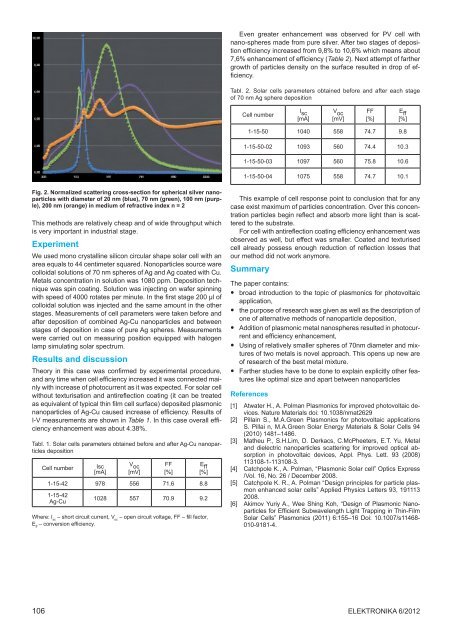Proceedings of the European Summer School of Photovoltaics 4 â 7 ...
Proceedings of the European Summer School of Photovoltaics 4 â 7 ...
Proceedings of the European Summer School of Photovoltaics 4 â 7 ...
Create successful ePaper yourself
Turn your PDF publications into a flip-book with our unique Google optimized e-Paper software.
Even greater enhancement was observed for PV cell with<br />
nano-spheres made from pure silver. After two stages <strong>of</strong> deposition<br />
efficiency increased from 9,8% to 10,6% which means about<br />
7,6% enhancement <strong>of</strong> efficiency (Table 2). Next attempt <strong>of</strong> far<strong>the</strong>r<br />
growth <strong>of</strong> particles density on <strong>the</strong> surface resulted in drop <strong>of</strong> efficiency.<br />
Tabl. 2. Solar cells parameters obtained before and after each stage<br />
<strong>of</strong> 70 nm Ag sphere deposition<br />
Cell number<br />
I sc<br />
[mA]<br />
V oc<br />
[mV]<br />
FF<br />
[%]<br />
E ff<br />
[%]<br />
1-15-50 1040 558 74.7 9.8<br />
1-15-50-02 1093 560 74.4 10.3<br />
1-15-50-03 1097 560 75.8 10.6<br />
1-15-50-04 1075 558 74.7 10.1<br />
Fig. 2. Normalized scattering cross-section for spherical silver nanoparticles<br />
with diameter <strong>of</strong> 20 nm (blue), 70 nm (green), 100 nm (purple),<br />
200 nm (orange) in medium <strong>of</strong> refractive index n = 2<br />
This methods are relatively cheap and <strong>of</strong> wide throughput which<br />
is very important in industrial stage.<br />
Experiment<br />
We used mono crystalline silicon circular shape solar cell with an<br />
area equals to 44 centimeter squared. Nonoparticles source ware<br />
colloidal solutions <strong>of</strong> 70 nm spheres <strong>of</strong> Ag and Ag coated with Cu.<br />
Metals concentration in solution was 1080 ppm. Deposition technique<br />
was spin coating. Solution was injecting on wafer spinning<br />
with speed <strong>of</strong> 4000 rotates per minute. In <strong>the</strong> first stage 200 µl <strong>of</strong><br />
colloidal solution was injected and <strong>the</strong> same amount in <strong>the</strong> o<strong>the</strong>r<br />
stages. Measurements <strong>of</strong> cell parameters were taken before and<br />
after deposition <strong>of</strong> combined Ag-Cu nanoparticles and between<br />
stages <strong>of</strong> deposition in case <strong>of</strong> pure Ag spheres. Measurements<br />
were carried out on measuring position equipped with halogen<br />
lamp simulating solar spectrum.<br />
Results and discussion<br />
Theory in this case was confirmed by experimental procedure,<br />
and any time when cell efficiency increased it was connected mainly<br />
with increase <strong>of</strong> photocurrent as it was expected. For solar cell<br />
without texturisation and antireflection coating (it can be treated<br />
as equivalent <strong>of</strong> typical thin film cell surface) deposited plasmonic<br />
nanoparticles <strong>of</strong> Ag-Cu caused increase <strong>of</strong> efficiency. Results <strong>of</strong><br />
I-V measurements are shown in Table 1. In this case overall efficiency<br />
enhancement was about 4.38%.<br />
Tabl. 1. Solar cells parameters obtained before and after Ag-Cu nanoparticles<br />
deposition<br />
Cell number<br />
Isc<br />
[mA]<br />
V oc<br />
[mV]<br />
FF<br />
[%]<br />
E ff<br />
[%]<br />
1-15-42 978 556 71.6 8.8<br />
1-15-42<br />
Ag-Cu<br />
1028 557 70.9 9.2<br />
Where: I sc<br />
– short circuit current, V oc<br />
– open circuit voltage, FF – fill factor,<br />
E ff<br />
– conversion efficiency.<br />
This example <strong>of</strong> cell response point to conclusion that for any<br />
case exist maximum <strong>of</strong> particles concentration. Over this concentration<br />
particles begin reflect and absorb more light than is scattered<br />
to <strong>the</strong> substrate.<br />
For cell with antireflection coating efficiency enhancement was<br />
observed as well, but effect was smaller. Coated and texturised<br />
cell already possess enough reduction <strong>of</strong> reflection losses that<br />
our method did not work anymore.<br />
Summary<br />
The paper contains:<br />
● broad introduction to <strong>the</strong> topic <strong>of</strong> plasmonics for photovoltaic<br />
application,<br />
● <strong>the</strong> purpose <strong>of</strong> research was given as well as <strong>the</strong> description <strong>of</strong><br />
one <strong>of</strong> alternative methods <strong>of</strong> nanoparticle deposition,<br />
● Addition <strong>of</strong> plasmonic metal nanospheres resulted in photocurrent<br />
and efficiency enhancement,<br />
● Using <strong>of</strong> relatively smaller spheres <strong>of</strong> 70nm diameter and mixtures<br />
<strong>of</strong> two metals is novel approach. This opens up new are<br />
<strong>of</strong> research <strong>of</strong> <strong>the</strong> best metal mixture.<br />
● Far<strong>the</strong>r studies have to be done to explain explicitly o<strong>the</strong>r features<br />
like optimal size and apart between nanoparticles<br />
References<br />
[1] Atwater H., A. Polman Plasmonics for improved photovoltaic devices.<br />
Nature Materials doi: 10.1038/nmat2629<br />
[2] Pillain S., M.A.Green Plasmonics for photovoltaic applications<br />
S. Pillai n, M.A.Green Solar Energy Materials & Solar Cells 94<br />
(2010) 1481–1486.<br />
[3] Ma<strong>the</strong>u P., S.H.Lim, D. Derkacs, C.McPheeters, E.T. Yu, Metal<br />
and dielectric nanoparticles scattering for improved optical absorption<br />
in photovoltaic devices, Appl. Phys. Lett. 93 (2008)<br />
113108-1-113108-3.<br />
[4] Catchpole K., A. Polman, “Plasmonic Solar cell” Optics Express<br />
/Vol. 16, No. 26 / December 2008.<br />
[5] Catchpole K. R., A. Polman “Design principles for particle plasmon<br />
enhanced solar cells” Applied Physics Letters 93, 191113<br />
2008.<br />
[6] Akimov Yuriy A., Wee Shing Koh, “Design <strong>of</strong> Plasmonic Nanoparticles<br />
for Efficient Subwavelength Light Trapping in Thin-Film<br />
Solar Cells” Plasmonics (2011) 6:155–16 Doi: 10.1007/s11468-<br />
010-9181-4.<br />
106<br />
Elektronika 6/2012

















